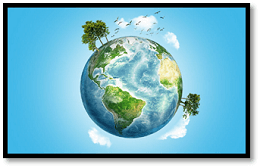Environment DefinitionA system including all biotic and abiotic components influencing human life can be expressed as a straightforward definition of an environment. All types of flora and fauna are categorized as biological or living elements, in contrast to abiotic elements such as water, light, air, and weather. Any product, service, or element that benefits individuals and society can be categorized as an environment's resource. Anything that satisfies a person's daily requirements could be one of them. Food produced by living things & plants, power used for cooking and heating, wind, and oil are only a few examples of environmental resources. 
The environment provides numerous products and services that are necessary to sustain life. Each resource is priceless and holds a particular amount of significance. A piece of land, for instance, might be turned into a park, a neighbourhood, a shopping mall, etc. Additionally, it can be used as a trash container. Meaning of Natural EnvironmentThe term "environment" in ecology and biology refers to all natural resources and living beings. If these elements are natural, the environment is considered to be natural. The environment is made up of both living and non-living objects that interact with or have an impact on an organism. Biologic elements are things that are alive and that an organism interacts with, such as animals, plants, and so forth. Abiotic elements are non-living substances like air, water, natural light, etc. Investigating the environment entails investigating the connections between these distinct elements. Plants obtaining their minerals from the soil and producing food utilizing sunlight are two examples of interactions between living and non-living entities. An example of living things interacting is when one creature eats another. Some individuals identify as environmentalists. They believe that in order to keep the environment safe, we must protect it. Natural resources are things in the natural surroundings that we value. For example, woods, fish, and insects. These resources regenerate themselves after use, making them renewable. Non-renewable resources are vital components of the environment that run out after a few thousand years, including ores and fossil fuels. Some natural phenomena, such as lightning, can kill people. Ecological entities that are largely untouched by human intervention. This encompasses all of the plant kingdom, microorganisms, soils, rocks, the atmosphere, & natural phenomena. Everyone has access to the same natural resources, and there are no clearly defined limits between physical phenomena. These include the sun, air, water, electricity, radiation, and magnetism. Functions of EnvironmentThe environment serves the following key purposes: 1. Life Is possible due to the environment Without human interference, the environment offers services necessary for maintaining life. Ecological diversity, UV defence, and climatic stability are a few of them. 2. It raises and enhances living standards A healthy lifestyle necessitates a clean atmosphere. In addition, people can enjoy and find enjoyment in all-natural aesthetic beauties like mountains, seas, deserts, etc. Humans must, however, take care to safeguard all of the land and resources and prevent them from contaminating them in order to maintain well-being. 3. It produces resources that are useful All resources, including renewable and non-renewable energy sources, come from the environment. Most of them are essential to survival. The sources that organisms utilize are both biotic and abiotic. We get our meals and animal products from plants and animals. The decomposing and dead stuff of organic substances is what creates fossil fuel. In addition to these extra ecosystem components, the environment also provides freshwater, wind, and possibly even metals. 4. The environment absorbs waste The environment can absorb waste products without endangering other living beings when absorption exceeds the assimilative threshold, pollution results. This kind of aptitude is demonstrated by the plants that dwell in water bodies' capacity to absorb pollutants, diseases, etc. Warnstorfia fluitans, an aquatic moss, may be able to remove toxic materials from water, according to a study. All living & non-living things found on Earth are included in the concept of nature, but what distinguishes nature from artificial objects is that it is a biological entity rather than one that has been "created" by humans. The environment, its elements, and the interactions between living things and their environments are all topics of research for several scientific disciplines. For instance, environmental studies are interested in examining how organisms interact with their environments and the results. Ecology is a subfield of environmental science that examines the ecological interactions inside ecosystems.
Next TopicHospital Definition
|
 For Videos Join Our Youtube Channel: Join Now
For Videos Join Our Youtube Channel: Join Now
Feedback
- Send your Feedback to [email protected]
Help Others, Please Share









